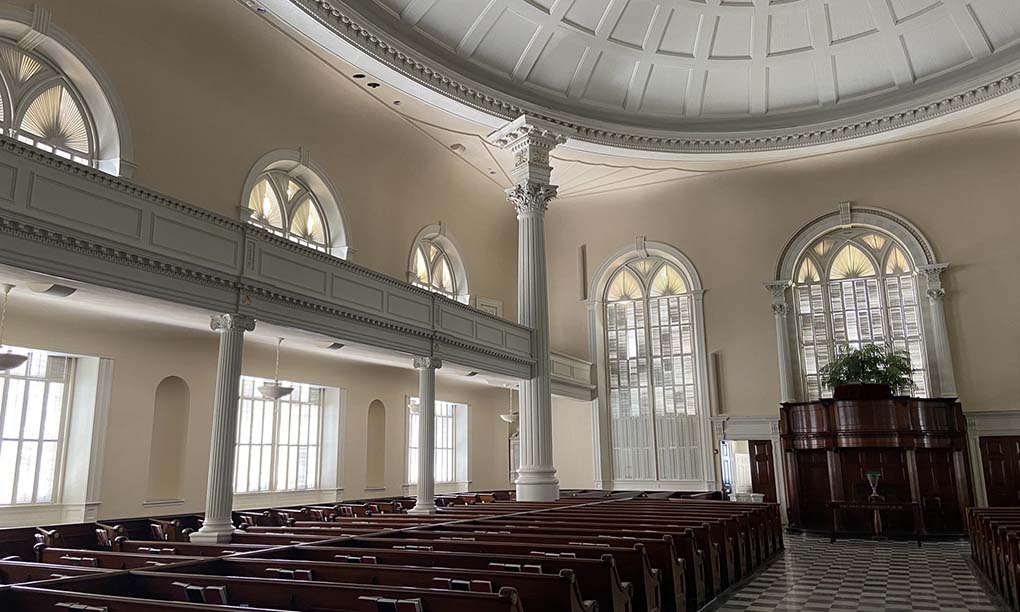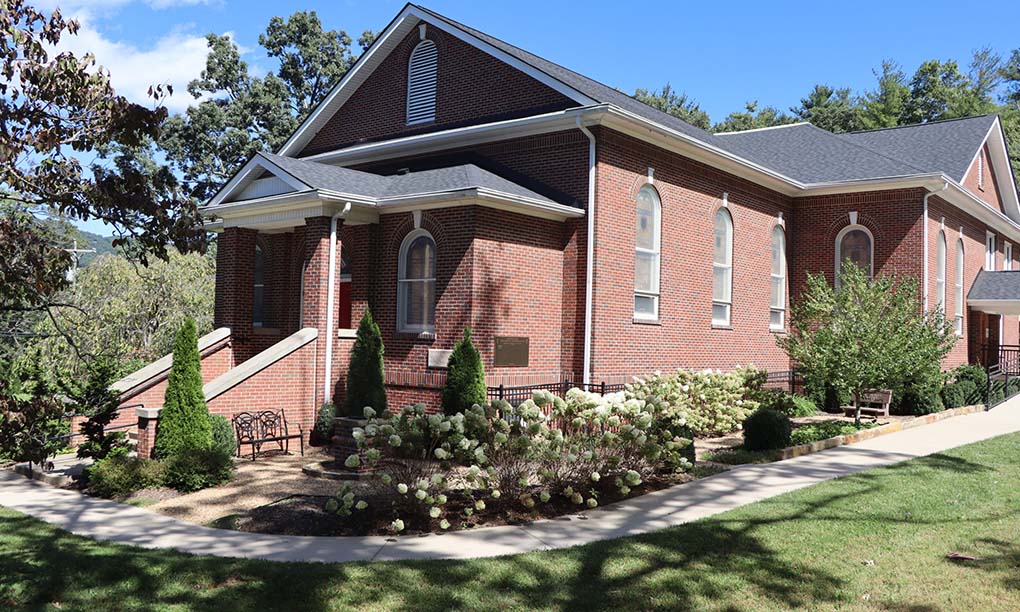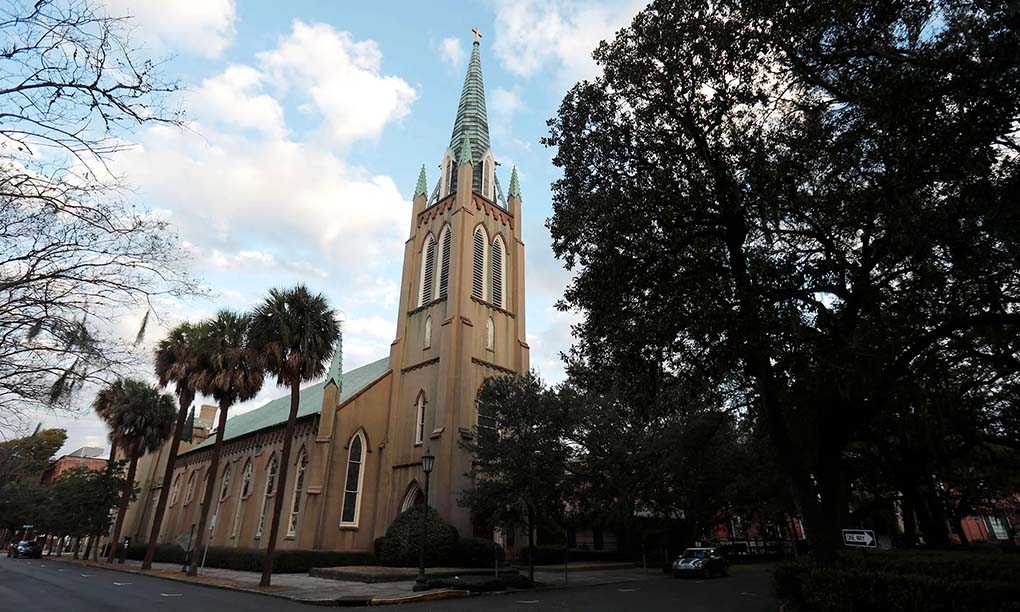Savannah, a city draped in Spanish moss and cloaked in history, reveals its narrative through the steeples that punctuate its skyline. My footsteps have echoed through the hallowed halls of these architectural marvels, each telling a tale etched in time. I’ll weave a tapestry of my encounters with three captivating churches and extend an invitation to discover four more, each with its unique historical resonance.
Cathedral of St. John the Baptist: Divine Elegance
Nestled at 222 E Harris St, Savannah, GA 31401, USA, the Cathedral of St. John the Baptist stands as a majestic testament to spiritual devotion and artistic opulence.
As I approached, the resplendent architecture of the Cathedral took my breath away. Its rich Catholic heritage echoed through the intricate details of the stained glass windows, the finely crafted altars, and the ethereal echoes of choir music that lingered in the air. The Cathedral emerged as a beacon, drawing me into a world where the divine and the artistic seamlessly converged.
The Cathedral offered not just a place of worship but an immersive journey into history. Regular Mass services provided a spiritual sanctuary, while guided tours extended an invitation to unravel the layers of the Cathedral’s past. The staff, with their attentive demeanor, added a layer of warmth to the overall experience, creating a harmonious blend of spiritual and cultural exploration.
While the primary purpose of the Cathedral is as a sanctuary, it occasionally transformed into a cultural hub. The sacred space hosted events and concerts, inviting the community to partake in the Cathedral’s embrace. The well-manicured grounds surrounding the Cathedral offered a serene oasis for quiet reflection, a retreat from the bustling energy of the Historic District.
Situated in the heart of the Historic District, the Cathedral beckoned exploration on foot. The narrow cobblestone streets led me to its grand entrance. For those opting for convenience, taxis, rideshares, and public transport were readily available, offering alternatives to a leisurely stroll.
Entry into the Cathedral was a gift in itself — complimentary. However, donations were graciously welcomed, contributing to the ongoing preservation efforts that safeguarded this historical haven.
Reservations for group tours or special events could be easily secured through the Cathedral’s official website. This ensured a deeper dive into the historical and cultural tapestry woven within the Cathedral’s walls.
Stepping across the threshold of the Cathedral of St. John the Baptist felt like embarking on a pilgrimage through centuries. The play of stained glass hues danced with the ethereal strains of hymns, creating an indelible impression on my Savannah sojourn. The Cathedral stood not just as a place of worship but as a living canvas, where the divine and the artistic merged seamlessly, leaving me with a profound sense of awe and reverence.
Independent Presbyterian Church: Understated Grace
Situated at 207 Bull St, Savannah, GA 31401, USA, the Independent Presbyterian Church beckons with its understated elegance, a timeless embodiment of simplicity and grace.
Approaching the Independent Presbyterian Church, I was greeted by a vision of classic Southern charm. The columns of white and a red-brick façade radiated understated elegance, inviting a sense of tranquility in the heart of the Historic District. It stood as a testament to a bygone era, where grace was found in the simplicity of architectural design.
Beyond its architectural allure, the Independent Presbyterian Church extended a warm invitation to worship services and guided tours. The regular worship services provided a spiritual anchor, while the guided tours, led by knowledgeable volunteers, unraveled the threads of the church’s history, fostering a sense of community engagement.

While primarily a house of worship, the church occasionally transformed into a cultural haven. Community events and cultural gatherings found a home within its walls, adding a vibrant layer to its identity. The serene courtyard, nestled within the church grounds, provided a tranquil sanctuary amidst the urban pulse.
Positioned conveniently in the Historic District, the Independent Presbyterian Church unfolded its charm for exploration on foot. The cobblestone streets guided me to its doorstep, offering a picturesque journey through the city’s past. For those opting for vehicular travel, ample parking facilities were available, ensuring easy accessibility.
The Independent Presbyterian Church embraced a spirit of inclusivity, with entry being a gift to all who ventured within its sacred space. Donations were encouraged, contributing to the ongoing preservation initiatives that safeguarded the church’s historical legacy.
Individual visits required no formal reservations, allowing for spontaneous moments of introspection. However, for those seeking a more curated experience through group tours or inquiries about special events, the church office welcomed direct communication.
The Independent Presbyterian Church, with its unassuming allure, became a haven for introspection amid the vivacious energy of Savannah. Its simplicity stood as a counterpoint to the city’s bustling atmosphere, offering a haven of calm in Savannah’s ecclesiastical landscape. As I stood within its walls, I felt a connection to a bygone era, where grace was found not in grandeur but in the quiet elegance of architectural simplicity. The Independent Presbyterian Church became a retreat, inviting me to pause and reflect in the embrace of its understated grace.
First African Baptist Church: Testament to Resilience
Nestled at 23 Montgomery St, Savannah, GA 31401, USA, the First African Baptist Church stands not only as a place of worship but as a living testament to the resilience and rich heritage of Savannah’s African American community.
As I approached the church, its significance unfolded in layers. Beyond its spiritual role, the First African Baptist Church emerged as a symbol of strength and faith. Its ties to the Underground Railroad, evident in its architectural features, resonated with stories of courage and tenacity.
The church welcomed all to its regular services, where the echoes of hymns mingled with the weight of history. Guided tours, led by knowledgeable narrators, delved into the church’s pivotal role in the Underground Railroad, providing a profound understanding of its place in Savannah’s African American heritage.
The First African Baptist Church wasn’t just a historical relic; it was a vibrant hub engaged with the community. Events celebrating culture, art, and history found a home within its walls, fostering a sense of inclusivity. The interior, adorned with historical artifacts, added authenticity to the visitor experience, creating a space where the past and present coexisted.
Positioned in the heart of the Historic District, the First African Baptist Church seamlessly blended into the fabric of Savannah’s historical tapestry. Exploring it on foot allowed for a nuanced understanding of its significance, as each step echoed with the stories of resilience that reverberated through time.
The church’s doors were open to all, with entry being a gift freely given. However, recognizing the importance of preserving its historical legacy, donations were encouraged, allowing visitors to contribute to the ongoing efforts dedicated to safeguarding the church’s rich heritage.
For those seeking a more curated experience through group tours or inquiries about special events, the church’s official website served as a portal for coordination. While individual visits required no formal reservations, the website provided a platform for deeper engagement with the church’s history.
Stepping within the hallowed walls of the First African Baptist Church felt like embarking on a pilgrimage through time. The echoes of the past, interwoven with the vibrant present, created a poignant narrative of resilience and communal strength. The church became an indispensable stop in my exploration of Savannah, offering a holistic grasp of the city’s diverse history. It stood not just as a place of worship but as a living monument, reminding all who entered of the enduring spirit that shaped Savannah’s African American community.
Recommendations for Further Exploration:
Christ Church Anglican: Colonial Reverie
Gracefully situated at 28 Bull St, Savannah, GA 31401, USA, Christ Church Anglican stands as a captivating testament to Savannah’s colonial heritage.
Approaching Christ Church Anglican, I was immediately struck by its colonial-era architecture, a living relic from Savannah’s early days. The moss-kissed cemetery that envelops the church adds a layer of historical richness, with weathered tombstones telling tales of a bygone era. The historic churchyard, serving as the final resting place for colonial figures, further amplifies the site’s significance.
Beyond its individual charm, Christ Church Anglican boasts proximity to other historical sites, facilitating a comprehensive exploration of Savannah’s colonial history. The serene churchyard, adorned with ancient oaks and weathered tombstones, offers a peaceful retreat within the bustling energy of the Historic District.
Navigating parking might pose a challenge due to limited space, and peak tourist seasons can attract crowds, potentially impacting the tranquility of the visit.
Christ Church Anglican stands as a colonial marvel, inviting visitors to step back in time. The architectural details, coupled with the moss-draped cemetery, create an ambiance where time seems to stand still. The ancient oaks, with their sprawling branches, and the whispers of history in the air foster an atmosphere conducive to contemplation. For history enthusiasts like me, this site became an essential stop, offering not just a glimpse but an immersive experience into Savannah’s colonial past.
Asbury Memorial United Methodist Church: Artistic Confluence
Gracefully positioned at 1008 E Henry St, Savannah, GA 31401, USA, Asbury Memorial United Methodist Church emerges as a testament to the harmonious merger of art and faith.
Approaching the church, I was immediately captivated by its artistic allure. The façade adorned with captivating stained glass windows and intricate woodwork hinted at the artistic treasures within. As I stepped inside, the interior unfolded as a canvas where art and faith seamlessly converged. The John Wesley Garden, with its natural serenity, added a touch of tranquility to the overall experience.

Asbury Memorial United Methodist Church wasn’t just a place of worship; it was a cultural hub committed to the arts. Regular concerts and cultural events showcased the church’s dedication to artistic expression, offering visitors a dynamic and immersive experience. The John Wesley Garden, a hidden gem within the church grounds, provided a tranquil haven for contemplation amid the urban bustle.
While the church’s artistic offerings were abundant, navigating parking could pose a challenge due to limited options. Careful planning for transportation became a consideration, ensuring a smooth and stress-free visit.
Stepping into Asbury Memorial United Methodist Church felt like entering a gallery of spiritual artistry. The vibrant hues of the stained glass windows painted stories of faith and devotion, while the intricate woodwork added a layer of craftsmanship that spoke to the church’s commitment to aesthetics. Beyond the visual, the melodic notes of the choir during services created an immersive experience that transcended conventional church visits. Asbury Memorial United Methodist Church became more than a place of worship; it became a dynamic space where art, culture, and faith converged, leaving a lasting impression on my exploration of Savannah’s churches.
Wesley Monumental United Methodist Church: Architectural Opulence
Proudly situated at 429 Abercorn St, Savannah, GA 31401, USA, Wesley Monumental United Methodist Church stands as a visual spectacle, showcasing the grandeur of Gothic Revival architecture.
The church, with its imposing presence, becomes an immediate focal point. The Gothic Revival architecture is a testament to the craftsmanship of a bygone era. The intricate details of the stained glass windows weave narratives of faith and history, while the soaring spire adds a vertical elegance that defines the church’s allure.
Wesley Monumental United Methodist Church’s central location in the heart of the Historic District makes it a convenient stop during a walking tour of Savannah. The architectural details, from the carefully crafted façade to the towering spire, offer a visual feast for enthusiasts of historical and architectural wonders.
The church’s popularity, driven by its architectural splendor, may lead to crowds, especially during special events or ceremonies. Navigating through the throngs of visitors could impact the tranquility that one might seek during a visit.
Wesley Monumental United Methodist Church stands as a testament to architectural opulence. The soaring spire, reaching towards the heavens, and the interplay of light through the stained glass windows create an atmosphere that appeals to both history enthusiasts and aficionados of fine craftsmanship. As I stood in its shadow, I couldn’t help but marvel at the intricacies that defined its exterior. Each detail seemed to tell a story, inviting visitors to unravel the layers of history and craftsmanship embedded within the walls of this majestic church. Wesley Monumental United Methodist Church became not just a stop on my journey through Savannah but a captivating chapter in the architectural narrative of the city.
Trinity United Methodist Church: Neo-Gothic Splendor
Gracing the landscape at 225 W President St, Savannah, GA 31401, USA, Trinity United Methodist Church emerges as a compelling example of Neo-Gothic design, commanding attention with its imposing façade.
The exterior of Trinity United Methodist Church is a testament to the architectural beauty that defines the Neo-Gothic style. The intricate details of the façade, from the pointed arches to the soaring spires, create a visual spectacle that captivates passersby. Stepping inside, the interior unfolds as a haven of intricate woodwork and vibrant stained glass, adding depth to the church’s historical significance.
Trinity United Methodist Church enjoys a strategic location near Forsyth Park, offering visitors the opportunity for a combined exploration of historical and natural attractions. The proximity to the park allows for a seamless transition from the structured beauty of the church to the organic allure of Forsyth Park. Additionally, the church’s commitment to enhancing the visitor experience is evident in its regular organ concerts, providing a harmonious backdrop to the exploration of its architectural marvels.
While Trinity United Methodist Church offers a rich visual and auditory experience, the challenge of limited parking options necessitates alternative transportation arrangements for those looking to visit. Planning ahead for parking or exploring alternative transportation methods becomes essential to fully enjoy the visit.
Trinity United Methodist Church stands as a neo-Gothic gem, drawing admirers into its timeless allure. The interplay of light and shadow within the sanctuary creates a mesmerizing ambiance that speaks to the craftsmanship of a bygone era. Trinity United Methodist Church is not just a stop; it’s a journey into the intricate details of Neo-Gothic splendor. As I explored its interior, I couldn’t help but appreciate the seamless fusion of history and artistry, making it a highly recommended destination for anyone traversing the cultural and architectural landscape of Savannah.
Savannah’s churches aren’t mere structures; they are living chapters in the city’s rich history. From the grandeur of the Cathedral of St. John the Baptist to the quiet elegance of the Independent Presbyterian Church and the resilience embodied by the First African Baptist Church, each church tells a unique story. I found these churches to be windows into Savannah’s soul, where faith, architecture, and community converge. My recommendations for further exploration invite fellow travelers to embark on a journey through time, where the spires of churches stand as guardians of Savannah’s enduring legacy.
Tags: Cathedral of St. John the Baptist, First African Baptist Church, Independent Presbyterian Church